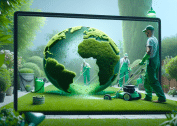Transforming your living space with energy efficient home upgrades can lead to surprising benefits. Discover practical strategies from insulation to eco-friendly appliances and how simple changes can help maximize comfort, reduce energy bills, and contribute to a greener planet—all while creating a more inviting home environment.
Understanding Energy Efficient Upgrades and Their Impact
Energy efficient home upgrades have become a topic of interest for many seeking improved comfort and lower utility costs. Homeowners are increasingly aware of environmental concerns and the advantages of sustainable choices. By focusing on energy saving improvements, not only is environmental impact reduced, but household expenditures can also see significant changes. Energy audits, insulation, and weatherization often top the list, setting a foundation for further improvements.
An energy audit is an initial step to understanding a home’s current efficiency. This assessment identifies where homes lose the most energy and suggests practical remedies. Insulation upgrades, for example, often follow these audits. Materials such as spray foam, fiberglass, or cellulose are widely used, each providing a barrier to unwanted heat loss or gain. Such measures are proven to create immediate changes in interior comfort levels while also contributing to longer-term savings on power bills (Source: https://www.energy.gov/energysaver/energy-saver).
The move toward energy efficiency isn’t only about financial prudence. Many individuals are motivated by the desire to support a sustainable future. Sustainable home upgrades involve choosing products that are durable, require less replacement and, as a result, have a smaller carbon footprint. The cumulative effect of these changes can be remarkable, both for personal finances and the broader environment, shifting the way society thinks about responsible living.
Exploring Types of Energy Efficient Upgrades
Not all upgrades are created equal. Some start with the basics like draft-proofing doors and windows, while others invest in smart thermostats or heating, ventilation, and air conditioning (HVAC) systems designed for efficiency. New technologies such as high-performance windows, smart thermostats, and energy efficient appliances stand out as simple yet high-impact choices for a modern home. Replacing traditional light bulbs with LEDs, for instance, is one of the fastest ways to start seeing savings.
Beyond common products, other substantial improvements include solar panels and advanced water heating systems. Solar panels utilize sunlight to provide free, renewable power, which is especially attractive for those aiming to reduce reliance on grid electricity (Source: https://www.nrel.gov/research/re-energize.html). Upgrading water heater systems, on the other hand, can deliver enhanced performance while using less energy overall. Hybrid and tankless water heaters are two options worth exploring.
Lifestyle changes also play a significant part in successful upgrades. Adjusting the thermostat by just a few degrees, sealing ducts, or installing window coverings can create measurable differences in utility usage. Even the outdoor space comes into play with energy-efficient landscaping—think of shading trees, drought-tolerant plants, or reflective roofing products. Each strategy can help cut energy demand and support long-term goals for greener living.
The Role of Insulation and Sealing in Home Energy Savings
Proper insulation keeps interior conditions comfortable while reducing the load on heating and cooling systems. Attics, basements, and crawl spaces are key areas to address when looking for major improvements, as heat often escapes through these less-insulated surfaces. Adding layers of the right insulation provides a solid defense against temperature swings, improving both warmth in winter and coolness in summer (Source: https://www.epa.gov/greenhomes/Insulation.htm).
Air leakage can quietly undermine even well-insulated homes. Gaps around doors, windows, plumbing penetrations, and electrical outlets allow conditioned air to escape. Caulking, weatherstripping, and expanding foam are affordable solutions that help maintain a stable indoor environment. Addressing these problem areas not only keeps spaces comfortable but also ensures HVAC equipment doesn’t work overtime, extending its lifespan and reducing overall home maintenance (Source: https://www.energystar.gov/campaign/seal_insulate).
A well-sealed and insulated home offers more than cost savings—it’s also a haven from drafts, dust, and outdoor pollutants. In older homes especially, these improvements can elevate everyday living quality. Indoor air quality benefits when outdoor irritants are blocked from entry. A consistent, comfortable environment is easier to maintain, letting homeowners enjoy peace of mind in every season.
Smart Technology and Automation for Efficient Living
Technology presents vast opportunities to streamline home energy consumption. Smart thermostats, for example, adjust temperature settings based on occupancy or daily routines, minimizing energy use when no one is home. These devices are easy to program and, in some cases, can be controlled remotely using smartphones, adding convenience to conservation (Source: https://www.energy.gov/articles/5-ways-save-smart-home).
Lighting technology is another area undergoing rapid development. LED bulbs and smart lighting systems consume less electricity, last longer, and can be operated on schedules or in response to daylight availability. Automating these systems ensures that energy is only used when needed—an innovation that can lead to lower power bills and a more sustainable lifestyle. Exploring utility rebates and incentives can further support the transition to efficient lighting throughout the home.
Home automation doesn’t stop at temperature and lighting. Appliances like washing machines, dishwashers, and refrigerators are increasingly available with energy saving modes or connectivity features. These smart appliances communicate with energy grids to operate during off-peak hours, balancing demand and cost. Adopting this technology may take initial investment, but the long-term gains in efficiency often justify the change.
Water Conservation and Eco-Friendly Features
Water efficiency is a key component of any modern home upgrade. Low-flow fixtures—such as toilets, showerheads, and faucets—use less water while maintaining desirable pressure and usability. Rainwater collection devices, drip irrigation, and drought-tolerant landscaping offer creative ways to conserve outside as well, contributing to reduced demand on municipal water systems (Source: https://www.epa.gov/watersense).
Appliances like high-efficiency washing machines and dishwashers help maximize every gallon of water. Choosing products certified by organizations such as WaterSense or ENERGY STAR ensures that savings are both credible and significant. These selections don’t just help the environment—they can lead to measurable financial savings throughout the lifespan of the appliance. Simple habit changes, like only running full loads or repairing leaks, maximize the effectiveness of these tools.
Materials used in home upgrades also matter. Opting for eco-friendly paints, recycled construction materials, or wood from certified sustainable sources can reduce harmful emissions and promote overall wellness. These choices support healthier indoor air and align with broader efforts to create homes that are as beneficial to residents as they are gentle on natural resources.
Financial Planning and Incentives for Home Upgrades
Tackling home upgrades may seem costly at first, but there are ways to keep expenses manageable. Budgeting for high-impact projects, such as attic insulation or appliance replacements, provides a clear focus. Many utility companies and government programs offer rebates, low-interest loans, or tax credits for energy efficient improvements. These incentives can make initial investments much more accessible and appealing (Source: https://www.dsireusa.org).
The return on investment often extends beyond mere reduction in utility bills. Increased property value is a little-discussed benefit. Homes with certified energy efficient features may attract buyers who prioritize sustainability and lower living costs. Certification labels, energy ratings, or detailed update lists can help communicate the value of efficient choices when it’s time to move or refinance.
To maximize success, homeowners may want to consult professionals or use online planning tools before launching projects. Free resources help estimate potential savings and compare options, offering peace of mind that upgrades are worthwhile. Prioritizing high-value areas and capitalizing on available incentives creates a sustainable path forward—enabling more households to benefit from practical, planet-friendly changes.
References
1. U.S. Department of Energy. (n.d.). Energy Saver Guide. Retrieved from https://www.energy.gov/energysaver/energy-saver.
2. National Renewable Energy Laboratory. (n.d.). Re-Energize Your Home. Retrieved from https://www.nrel.gov/research/re-energize.html.
3. U.S. Environmental Protection Agency. (n.d.). Insulation. Retrieved from https://www.epa.gov/greenhomes/Insulation.htm.
4. ENERGY STAR. (n.d.). Seal and Insulate. Retrieved from https://www.energystar.gov/campaign/seal_insulate.
5. U.S. Environmental Protection Agency. (n.d.). WaterSense. Retrieved from https://www.epa.gov/watersense.
6. Database of State Incentives for Renewables & Efficiency. (n.d.). Program List. Retrieved from https://www.dsireusa.org.









